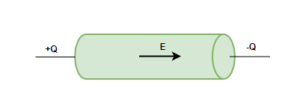Table of Contents
The flow of electrons through a conductor is referred to as electric current. The movement of these charged particles causes a voltage or electrical potential difference to be created between two points in a circuit. This difference in potential can be used to power electronic devices and appliances. To study electric current in conductors, it is necessary to first understand how electrons move and what factors influence their flow. Understanding the fundamentals of electricity allows you to learn about electric current in conductors and how to apply it in your own life more effectively. Electric currents run through the devices we use every day. Electric devices with electric currents flowing into them include torches, bulbs, fans, heaters, and so on. Assume that charges are flowing horizontally and that a surface with a small area is held normal to the direction of charge flow. Assume that both positive and negative charges flow through this area. If an electric field is applied to an electric charge, the charge begins to move as a result of the force, and the movement of these charges constitutes the electric current. Atoms in a solid conductor are tightly bound to each other, and nearly all of the electrons are bound to the atoms. Some electrons are free from all the atoms and can move freely throughout the material. When no electric field is present, these electrons move in random directions. There is no preferential direction for electron velocities at any given time. This means that the average number of electrons moving in any direction will be equal to the number of electrons moving in the opposite direction. As a result, there will be no net electrical current.

Solved Solutions
Q. The amount of charge passed through a cross-section of a wire in time t is ![]()
(a) Create dimensional formulas for A, B, and C.
(b) Determine the value of current at ![]() if the numerical values of A, B, and C are 5, 3, and 1 in SI units, respectively.
if the numerical values of A, B, and C are 5, 3, and 1 in SI units, respectively.
Solution:
(a) [Q]=[A][T]2=[B][T]=[C]
[I][T]=[A][T]2=[B][T]=[C]
[A]=[IT-1]
[B]=[I]
[C]=[IT]
(b)
I=2At+B
I=2(5)(5)+3
I=53A
Question: Electrons are emitted by an![]() electron gun at a rate of one per second. What is the corresponding electric current?
electron gun at a rate of one per second. What is the corresponding electric current?
Solution:
![]()
![]()
![]()
Question: A discharge tube has an electric current of 2.0 μA. . In 5 minutes, how much charge is transferred across a cross-section of the tube?
Solution:
![]()
![]()
Question: A copper wire with a cross-section of 1.0mm2 has a current of 1.0 A. Calculate the drift speed of the free electrons in the wire assuming one free electron per atom. Copper has a density of 9000kg/m3.
Solution:
![]()
![]()
![]()
![]()
![]()
![]()
![]()
![]()
![]()
Question: A wire with a length of 1m and a radius of 0.1mm has a resistance of 100Ω. Determine the material’s resistivity.
Solution:
![]()
![]()
![]() Ω.m
Ω.m
FAQs
What is the definition of an electrical conductor?
Electrical conductors are bodies in which the application of an electric field results in the generation of electric current due to electron movement.
What exactly is electric current?
An electric current is a flow of charged particles, such as electrons or ions, through a conductor.




